Impact of Wood on Perception of Transient and Steady-State Indoor Thermal Environments
Abstract
1. Introduction
2. Materials and Methods
2.1. First Experiment
2.2. Second Experiment
2.3. Statistical Analysis
3. Results
3.1. First Experiment
3.2. Second Experiment
4. Discussion
5. Conclusions
Author Contributions
Funding
Data Availability Statement
Acknowledgments
Conflicts of Interest
References
- Leech, J.A.; Nelson, W.C.; Burnett, R.T.; Aaron, S.; Raizenne, M.E. It’s about time: A comparison of Canadian and American time–activity patterns. J. Expo. Sci. Environ. Epidemiol. 2002, 12, 427–432. [Google Scholar] [CrossRef] [PubMed]
- U.S. Energy Information Administration (EIA). Monthly Energy Review, U.S. Energy Flow. 2018. Available online: https://www.eia.gov/totalenergy/data/monthly/pdf/mer.pdf (accessed on 25 March 2020).
- International Energy Agency (IEA). 2019 Global Status Report for Buildings and Construction. Available online: https://www.unenvironment.org/resources/publication/2019-global-status-report-buildings-and-construction-sector (accessed on 25 March 2020).
- American Society of Heating, Refrigerating and Air Conditioning Engineers. ANSI/ASHRAE Standard 55-2017, Thermal Environmental Conditions for Human Occupancy; ASHRAE: Atlanta, GA, USA, 2017. [Google Scholar]
- De Dear, R.; Brager, G.S. Developing an adaptive model of thermal comfort and preference. ASHRAE Trans. 1998, 104, 145–167. [Google Scholar]
- Nikolopoulou, M.; Steemers, K. Thermal comfort and psychological adaptation as a guide for designing urban spaces. Energy Build. 2003, 35, 95–101. [Google Scholar] [CrossRef]
- Broman, N.O. Aesthetic properties in knotty wood surfaces and their connection with people’s preferences. J. Wood Sci. 2001, 47, 192–198. [Google Scholar] [CrossRef]
- Zhou, Y.; Zhao, X.; Feng, Y.; Xuan, C.; Yang, C.; Jia, X. Effects of Visual Perception of Building Materials on Human Emotional States and Cognitive Functioning in a Physical Learning Environment. Buildings 2025, 15, 1163. [Google Scholar] [CrossRef]
- Rice, J.; Kozak, R.A.; Meitner, M.J.; Cohen, D.H. Appearance wood products and psychological well-being. Wood Fiber Sci. 2007, 38, 644–659. [Google Scholar]
- Nyrud, A.Q.; Bringslimark, T.; Bysheim, K. Benefits from wood interior in a hospital room: A preference study. Archit. Sci. Rev. 2014, 57, 125–131. [Google Scholar] [CrossRef]
- Wastiels, L.; Schifferstein, H.N.; Heylighen, A.; Wouters, I. Relating material experience to technical parameters: A case study on visual and tactile warmth perception of indoor wall materials. Build. Environ. 2012, 49, 359–367. [Google Scholar] [CrossRef]
- Kardan, O.; Demiralp, E.; Hout, M.C.; Hunter, M.R.; Karimi, H.; Hanayik, T.; Yourganov, G.; Jonides, J.; Berman, M.G. Is the preference of natural versus man-made scenes driven by bottom–up processing of the visual features of nature? Front. Psychol. 2015, 6, 471. [Google Scholar] [CrossRef]
- Masuda, M. Visual characteristics of wood and the psychological images (in Japanese). Mokuzai Gakkaishi J. Jpn. Wood Res. Soc. 1992, 38, 1075–1081. [Google Scholar]
- Mogensen, M.F.; English, H.B. The Apparent Warmth of Colors. Am. J. Psychol. 1926, 37, 427–428. [Google Scholar] [CrossRef]
- Kim, S.; Jin, D.; Yun, B.Y.; Nam, J.; Kim, S. Assessing thermal comfort in wooden buildings: A visual perceptual analysis through physiological characterization. Energy Build. 2024, 324, 114918. [Google Scholar] [CrossRef]
- Kim, S.; Yun, B.Y.; Choi, J.Y.; Kim, Y.U.; Kim, S. Quantification of visual thermal perception changes in a wooden interior environment using physiological responses and immersive virtual environment. Build. Environ. 2023, 240, 110420. [Google Scholar] [CrossRef]
- Sakuragawa, S.; Miyazaki, Y.; Kaneko, T.; Makita, T. Influence of wood wall panels on physiological and psychological responses. J. Wood Sci. 2005, 51, 136–140. [Google Scholar] [CrossRef]
- Tsunetsugu, Y.; Miyazaki, Y.; Sato, H. Physiological effects in humans induced by the visual stimulation of room interiors with different wood quantities. J. Wood Sci. 2007, 53, 11–16. [Google Scholar] [CrossRef]
- Wu, Y.; Jiang, A.; Liu, H.; Li, B.; Kosonen, R. Climate chamber investigation of the effect of indoor thermal histories on thermal adaptation in different seasons. Energy Built Environ. 2024, 5, 455–463. [Google Scholar] [CrossRef]
- Buonocore, C.; De Vecchi, R.; Scalco, V.; Lamberts, R. Influence of recent and long-term exposure to air-conditioned environments on thermal perception in naturally-ventilated classrooms. Build. Environ. 2019, 156, 233–242. [Google Scholar] [CrossRef]
- Wu, Y.; Liu, H.; Chen, B.; Li, B.; Kosonen, R.; Jokisalo, J.; Chen, T. Effect of long-term thermal history on physiological acclimatization and prediction of thermal sensation in typical winter conditions. Build. Environ. 2020, 179, 106936. [Google Scholar] [CrossRef]
- Luo, M.; Ke, Z.; Ji, W.; Wang, Z.; Cao, B.; Zhou, X.; Zhu, Y. The time-scale of thermal comfort adaptation in heated and unheated buildings. Build. Environ. 2019, 151, 175–186. [Google Scholar] [CrossRef]
- Ning, H.; Wang, Z.; Ji, Y. Thermal history and adaptation: Does a long-term indoor thermal exposure impact human thermal adaptability? Appl. Energy 2016, 183, 22–30. [Google Scholar] [CrossRef]
- Jiang, Y.; Xie, Y.; Niu, J. Short-term dynamic thermal perception and physiological response to step changes between real-life indoor and outdoor environments. Build. Environ. 2024, 251, 111223. [Google Scholar] [CrossRef]
- Vellei, M.; Le Dréau, J. A novel model for evaluating dynamic thermal comfort under demand response events. Build. Environ. 2019, 160, 106215. [Google Scholar] [CrossRef]
- De Dear, R.J.; Ring, J.W.; Fanger, P.O. Thermal sensations resulting from sudden ambient temperature changes. Indoor Air 1993, 3, 181–192. [Google Scholar] [CrossRef]
- Nagano, K.; Takaki, A.; Hirakawa, M.; Tochihara, Y. Effects of ambient temperature steps on thermal comfort requirements. Int. J. Biometeorol. 2005, 50, 33–39. [Google Scholar] [CrossRef]
- Wu, Y.C.; Mahdavi, A. Assessment of thermal comfort under transitional conditions. Build. Environ. 2014, 76, 30–36. [Google Scholar] [CrossRef]
- Ji, W.; Cao, B.; Geng, Y.; Zhu, Y.; Lin, B. Study on human skin temperature and thermal evaluation in step change conditions: From non-neutrality to neutrality. Energy Build. 2017, 156, 29–39. [Google Scholar] [CrossRef]
- Rohles, F.H.; Wells, W.V. The role of environmental antecedents on subsequent thermal comfort. ASHRAE Trans. 1977, 83, 21–29. [Google Scholar]
- R Core Team. R: A Language and Environment for Statistical Computing; R Foundation for Statistical Computing: Vienna, Austria, 2017; Available online: https://www.R-project.org/ (accessed on 25 March 2020).
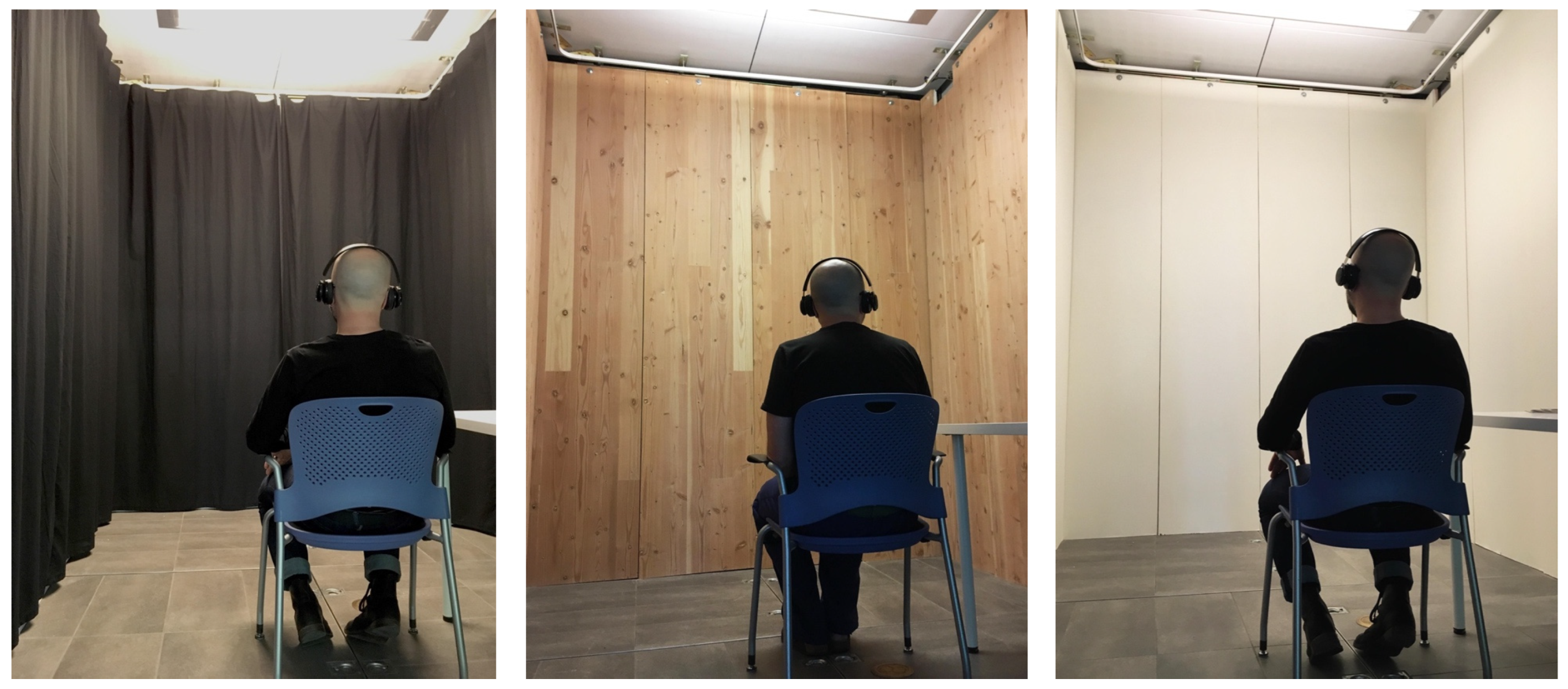
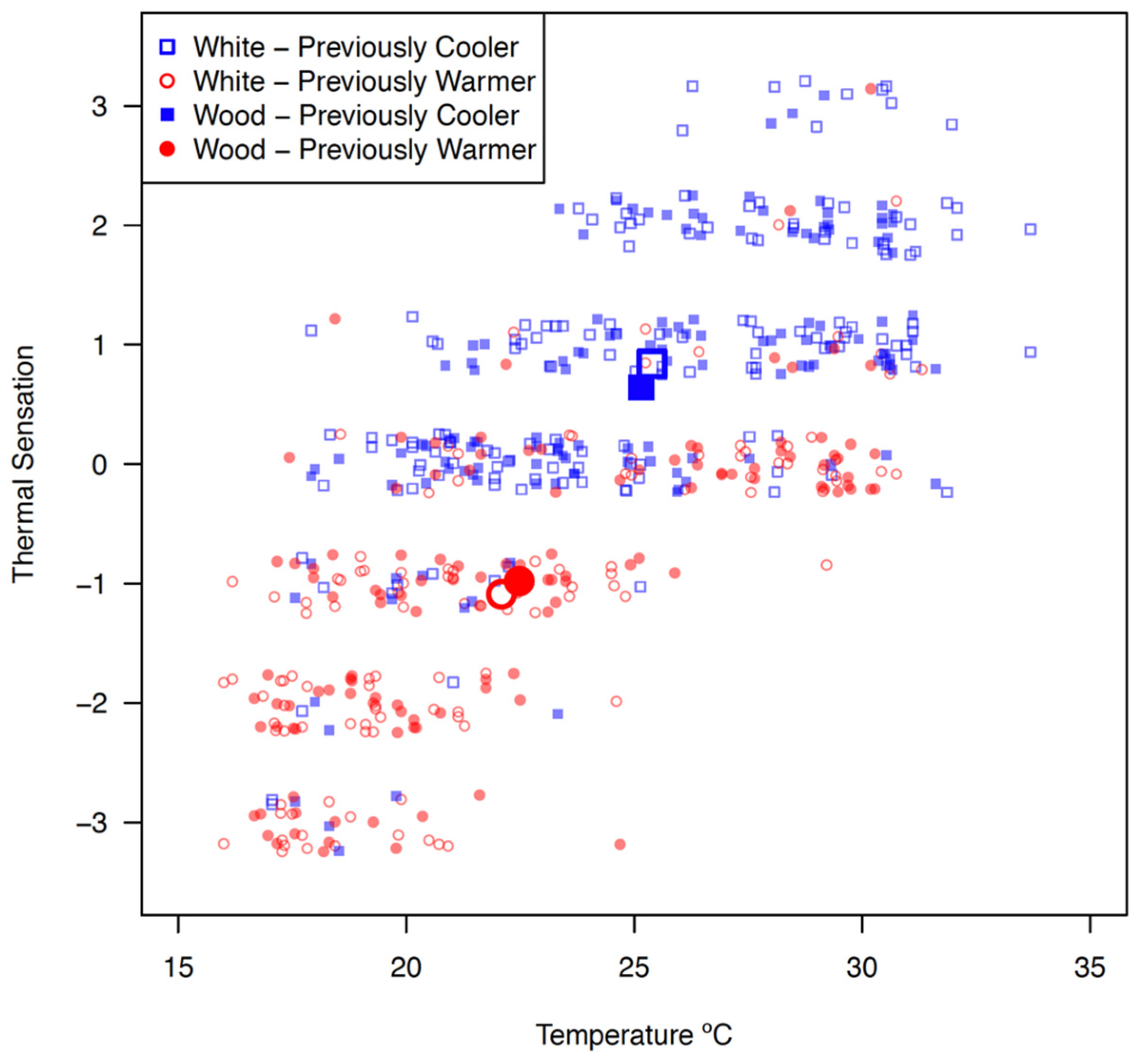
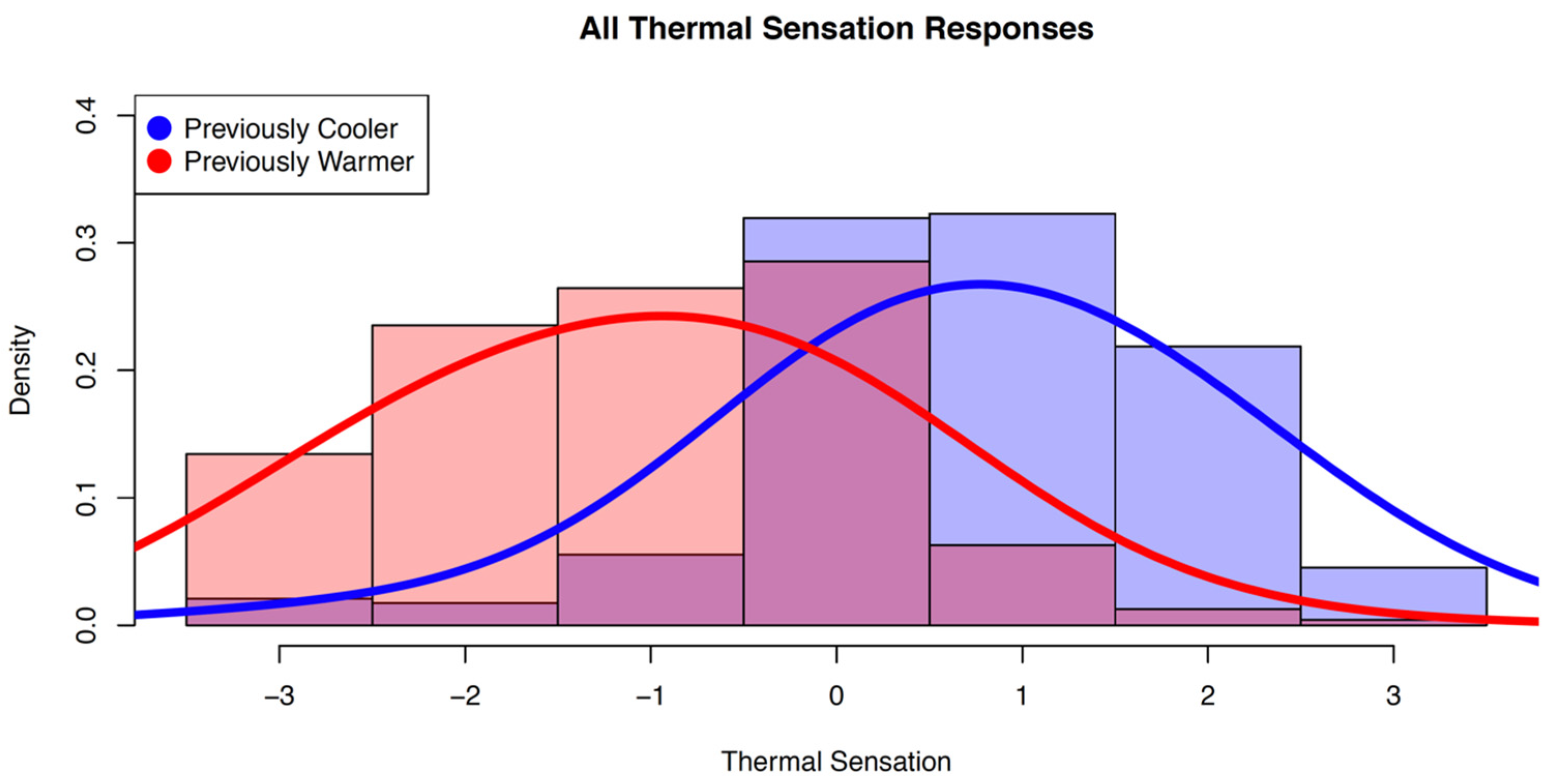


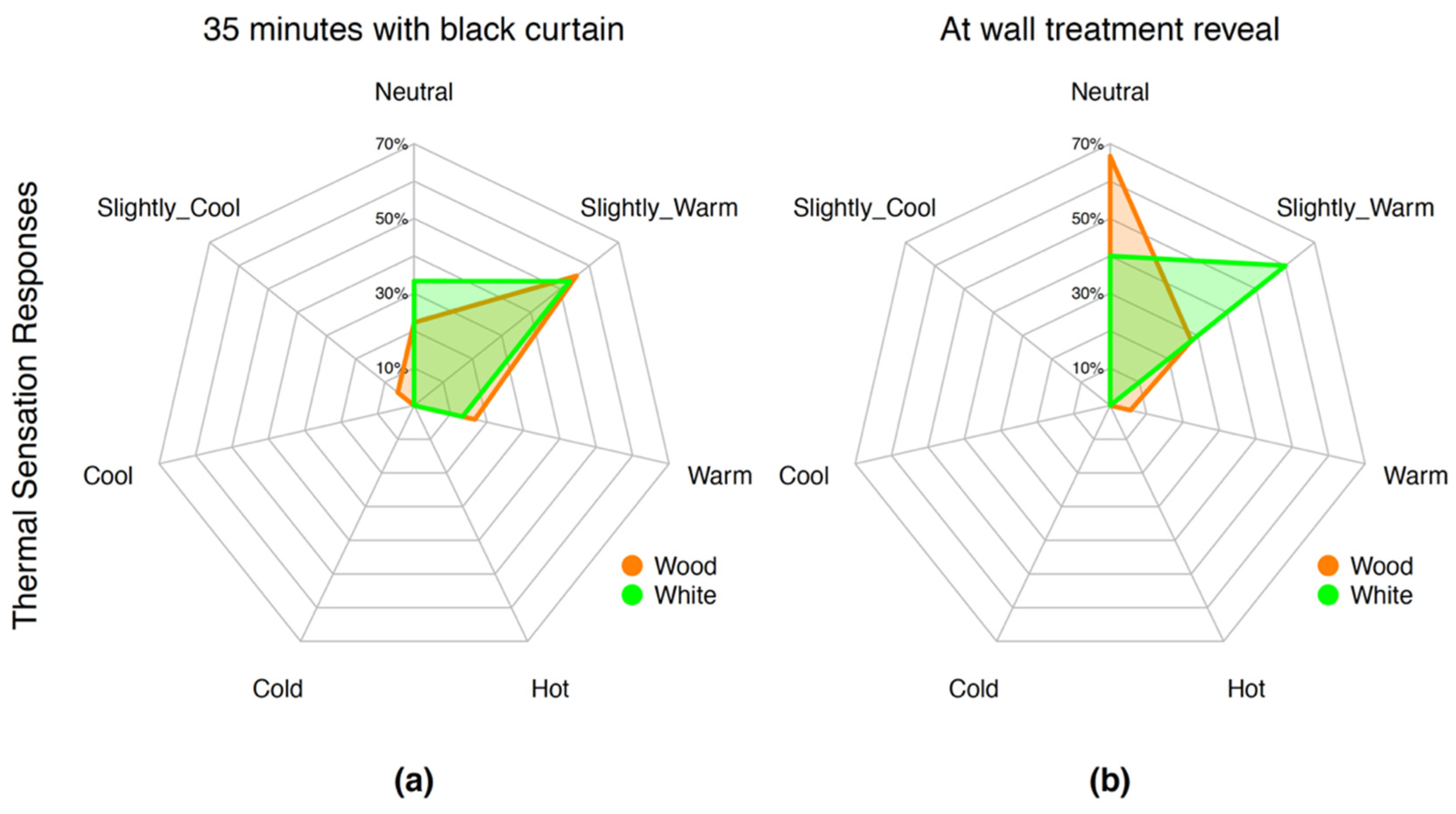
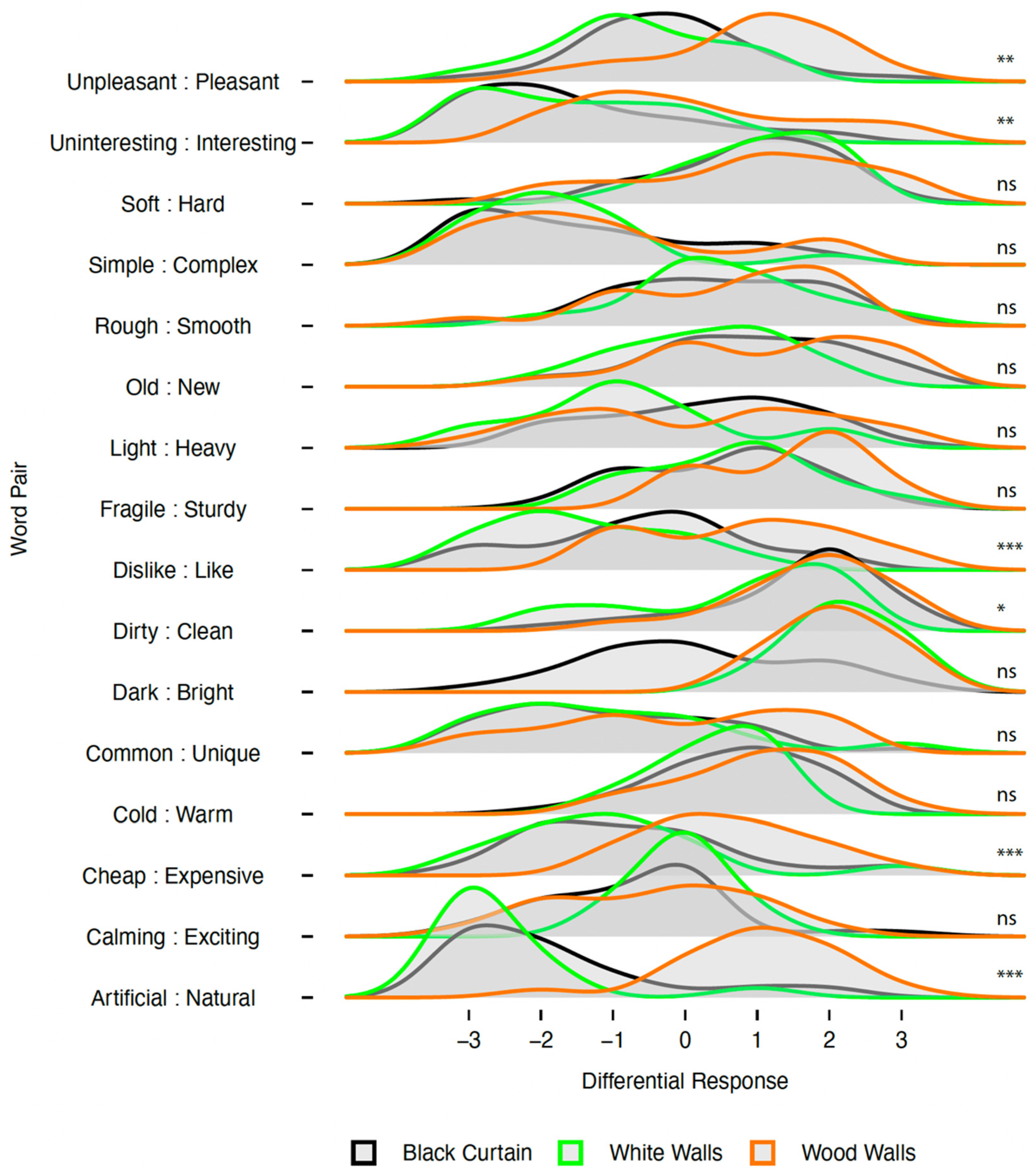
Disclaimer/Publisher’s Note: The statements, opinions and data contained in all publications are solely those of the individual author(s) and contributor(s) and not of MDPI and/or the editor(s). MDPI and/or the editor(s) disclaim responsibility for any injury to people or property resulting from any ideas, methods, instructions or products referred to in the content. |
© 2025 by the authors. Licensee MDPI, Basel, Switzerland. This article is an open access article distributed under the terms and conditions of the Creative Commons Attribution (CC BY) license (https://creativecommons.org/licenses/by/4.0/).
Share and Cite
Gravelle, D.; Stenson, J.; Fretz, M.; Van Den Wymelenberg, K. Impact of Wood on Perception of Transient and Steady-State Indoor Thermal Environments. Buildings 2025, 15, 1698. https://doi.org/10.3390/buildings15101698
Gravelle D, Stenson J, Fretz M, Van Den Wymelenberg K. Impact of Wood on Perception of Transient and Steady-State Indoor Thermal Environments. Buildings. 2025; 15(10):1698. https://doi.org/10.3390/buildings15101698
Chicago/Turabian Style(Blankenberger) Gravelle, Denise, Jason Stenson, Mark Fretz, and Kevin Van Den Wymelenberg. 2025. "Impact of Wood on Perception of Transient and Steady-State Indoor Thermal Environments" Buildings 15, no. 10: 1698. https://doi.org/10.3390/buildings15101698
APA StyleGravelle, D., Stenson, J., Fretz, M., & Van Den Wymelenberg, K. (2025). Impact of Wood on Perception of Transient and Steady-State Indoor Thermal Environments. Buildings, 15(10), 1698. https://doi.org/10.3390/buildings15101698







